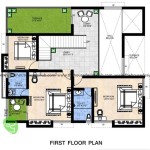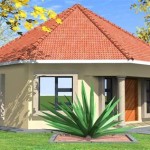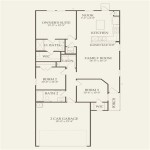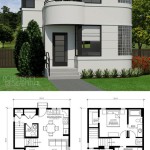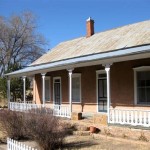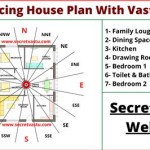Modern Home Plans for Sloped Lots: Navigating Challenges and Maximizing Potential
Sloped lots present both challenges and unique opportunities in residential architecture. While a level building site is often preferred, sloped properties can be leveraged to create visually striking and highly functional modern homes. The key lies in selecting or adapting modern home plans specifically designed to address the intricacies of the terrain. These plans must consider foundational stability, drainage, accessibility, and the integration of the home with the natural landscape.
Modern architecture, with its emphasis on clean lines, large windows, and open layouts, can be particularly well-suited to sloped lots. Thoughtful design can maximize natural light, offer panoramic views, and create dynamic interior spaces that respond to the contours of the land. This article explores the essential considerations for selecting and implementing modern home plans on sloped lots, focusing on the core principles that ensure both structural integrity and aesthetic harmony.
Understanding Slope Grade and Soil Composition
Before embarking on any construction project on a sloped lot, a thorough site assessment is paramount. This assessment should include a detailed topographic survey to determine the precise slope grade and an in-depth soil analysis to understand its composition and stability. The slope grade dictates the type of foundation required and influences the overall design approach. Steep slopes often necessitate more complex and costly foundation systems, such as stepped foundations, retaining walls, or pier and beam construction. Conversely, gently sloping lots may allow for more conventional slab-on-grade foundations with minimal modification.
Soil composition is equally crucial. Different soil types exhibit varying degrees of stability, drainage capacity, and susceptibility to erosion. Sandy soils, for example, drain well but may be less stable than clay soils, which retain water and can expand or contract with changes in moisture content. A geotechnical engineer should conduct soil testing to determine the soil's bearing capacity and identify any potential hazards, such as expansive soils or underground water sources. This information will inform the foundation design and ensure the long-term structural integrity of the home.
The site assessment should also consider the existing vegetation and its impact on soil stability. Mature trees and shrubs can help to prevent erosion and provide natural drainage. However, their root systems can also interfere with foundation construction and require careful management. A comprehensive site plan should identify areas where vegetation needs to be removed or preserved, and should incorporate strategies for mitigating erosion and promoting healthy plant growth.
Foundation Options for Sloped Lots in Modern Home Designs
The foundation is the most critical element of any home built on a sloped lot. Choosing the right foundation type is essential for ensuring stability, preventing moisture intrusion, and creating a level platform for the rest of the house. Several foundation options are commonly used in modern home plans for sloped lots, each with its own advantages and disadvantages.
Stepped Foundations: Stepped foundations are a versatile option for moderately sloped lots. They consist of a series of concrete footings and walls that step up or down the slope, creating a level building platform at each step. This approach minimizes the amount of excavation required and allows the home to follow the natural contours of the land. Stepped foundations are relatively cost-effective and can be adapted to a variety of slope grades.
Walk-Out Basements: A walk-out basement is an excellent choice for steeply sloped lots. This type of foundation involves excavating into the slope to create a full or partial basement level that is exposed on one or more sides. The exposed side of the basement can serve as an entrance or exit, providing direct access to the outdoors. Walk-out basements maximize usable living space and can be finished to create additional bedrooms, living areas, or recreational spaces.
Pier and Beam Foundations: Pier and beam foundations are a good option for lots with unstable soil or steep slopes. This type of foundation consists of a series of concrete or steel piers that are driven into the ground to support a framework of beams. The house is then built on top of this framework, elevating it above the ground. Pier and beam foundations minimize site disturbance and allow for natural drainage, reducing the risk of erosion and flooding.
Cantilevered Foundations: Cantilevered foundations are often employed in modern designs to create dramatic overhangs and floating forms. They involve extending a portion of the house beyond the foundation wall, supported by reinforced beams and columns. While visually striking, cantilevered foundations require careful engineering and can be more expensive than other options. They are best suited for experienced builders and architects.
Integrating Design with the Natural Environment
Modern home plans for sloped lots should strive to integrate the home seamlessly with the surrounding landscape. This involves considering the orientation of the house, the use of natural materials, and the creation of outdoor living spaces that complement the indoor environment.
Orientation and Views: The orientation of the house should be carefully considered to maximize natural light, optimize views, and minimize exposure to harsh weather conditions. In general, homes should be oriented to take advantage of southern exposure, which provides warmth and sunlight during the winter months. Large windows and sliding glass doors can be strategically placed to capture panoramic views of the surrounding landscape. Overhangs and shading devices can be used to protect the interior from excessive heat gain during the summer months.
Material Selection: The choice of building materials can have a significant impact on the overall aesthetic of the home and its integration with the natural environment. Natural materials, such as wood, stone, and brick, can blend harmoniously with the surrounding landscape. The use of sustainable and locally sourced materials is also encouraged, as it reduces the environmental impact of the construction process. Modern homes often incorporate a mix of natural and synthetic materials, such as concrete, steel, and glass, to create a contemporary and visually striking design.
Outdoor Living Spaces: Sloped lots offer unique opportunities for creating outdoor living spaces that seamlessly connect with the indoor environment. Decks, patios, and balconies can be built at different levels to take advantage of the slope and provide multiple vantage points. Retaining walls can be used to create level terraces for gardening, entertaining, or relaxing. Outdoor kitchens, fire pits, and water features can further enhance the enjoyment of the outdoor space. Careful landscaping can soften the transition between the house and the surrounding landscape, creating a sense of privacy and tranquility.
Drainage and Erosion Control: Proper drainage and erosion control are essential for protecting the home and the surrounding landscape from water damage. Sloped lots are particularly susceptible to erosion, so it is important to implement strategies for diverting water away from the foundation and preventing soil loss. This can include installing drainage swales, retaining walls, and erosion control blankets. Native plants can also be used to stabilize the soil and provide natural drainage. Rainwater harvesting systems can be installed to collect and reuse rainwater for irrigation or other purposes, reducing the demand on municipal water supplies.
Accessibility Considerations: Building on a sloped lot can present challenges for accessibility, particularly for individuals with mobility limitations. Ramps, elevators, and chairlifts can be incorporated into the design to provide access to different levels of the house. Universal design principles should be applied throughout the home to ensure that it is accessible and usable by people of all ages and abilities. This includes features such as wider doorways, grab bars in bathrooms, and lever-style door handles.
In conclusion, modern home plans for sloped lots require careful consideration of site conditions, foundation options, and integration with the natural environment. By addressing these factors in a thoughtful and comprehensive manner, architects and builders can create beautiful, functional, and sustainable homes that take full advantage of the unique opportunities presented by sloped properties. A well-designed home on a sloped lot can offer stunning views, enhanced privacy, and a strong connection to the surrounding landscape.

Modern House Plans For Sloped Lots Fresh 29 Best Steep Slope Images On Sloping Lot Plan

Modern House Plan Sloping Lot Contemporary Style 5590 Vista

Plan 51696 Traditional Hillside Home With 1736 Sq Ft 3 Be

The Best House Plans For Sloped Lots And Narrow Houseplans Blog Com

Plan 85325ms 3 Bed Modern House For The Rear Sloping Lot Lake Plans

Sloped Lot House Plans Down Slope The Designers

Home Plan Ch507

Hillside And Sloped Lot House Plans

Modern Style House Plan 4 Beds 3 5 Baths 3056 Sq Ft 498 6 Beach Flooring Sloping Lot Plans

Dream House Plans For Sloping Sloped Lots

